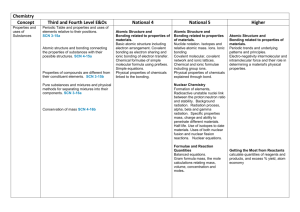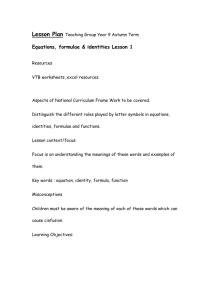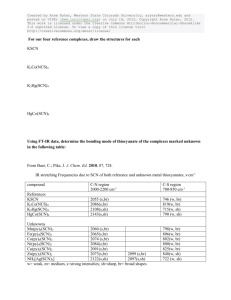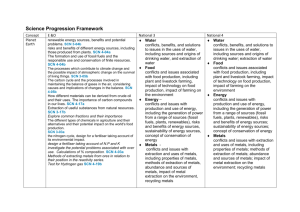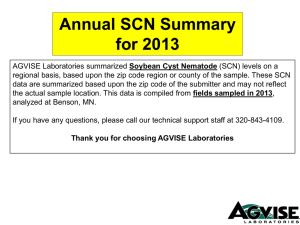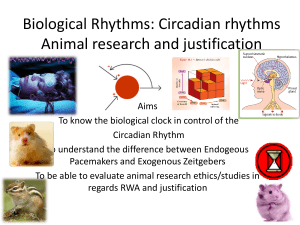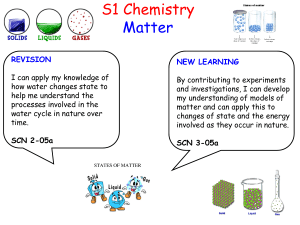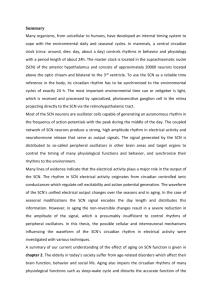Chemistry Concept Key Areas E&O National 3 National 4 National 5
advertisement
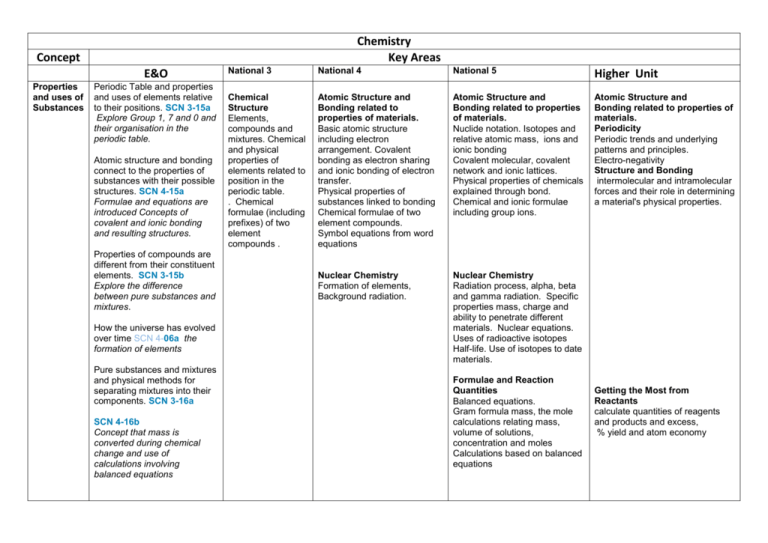
Chemistry Key Areas Concept E&O Properties and uses of Substances Periodic Table and properties and uses of elements relative to their positions. SCN 3-15a Explore Group 1, 7 and 0 and their organisation in the periodic table. Atomic structure and bonding connect to the properties of substances with their possible structures. SCN 4-15a Formulae and equations are introduced Concepts of covalent and ionic bonding and resulting structures. Properties of compounds are different from their constituent elements. SCN 3-15b Explore the difference between pure substances and mixtures. How the universe has evolved over time SCN 4-06a the formation of elements Pure substances and mixtures and physical methods for separating mixtures into their components. SCN 3-16a SCN 4-16b Concept that mass is converted during chemical change and use of calculations involving balanced equations National 3 National 4 National 5 Higher Unit Chemical Structure Elements, compounds and mixtures. Chemical and physical properties of elements related to position in the periodic table. . Chemical formulae (including prefixes) of two element compounds . Atomic Structure and Bonding related to properties of materials. Basic atomic structure including electron arrangement. Covalent bonding as electron sharing and ionic bonding of electron transfer. Physical properties of substances linked to bonding Chemical formulae of two element compounds. Symbol equations from word equations Atomic Structure and Bonding related to properties of materials. Nuclide notation. Isotopes and relative atomic mass, ions and ionic bonding Covalent molecular, covalent network and ionic lattices. Physical properties of chemicals explained through bond. Chemical and ionic formulae including group ions. Atomic Structure and Bonding related to properties of materials. Periodicity Periodic trends and underlying patterns and principles. Electro-negativity Structure and Bonding intermolecular and intramolecular forces and their role in determining a material's physical properties. Nuclear Chemistry Formation of elements, Background radiation. Nuclear Chemistry Radiation process, alpha, beta and gamma radiation. Specific properties mass, charge and ability to penetrate different materials. Nuclear equations. Uses of radioactive isotopes Half-life. Use of isotopes to date materials. Formulae and Reaction Quantities Balanced equations. Gram formula mass, the mole calculations relating mass, volume of solutions, concentration and moles Calculations based on balanced equations Getting the Most from Reactants calculate quantities of reagents and products and excess, % yield and atom economy Earth’s Materials Society's energy needs, the risks and benefits of different energy sources, including those produced from plants. SCN 4-04a Fuels and Energy Environmental impact of using different energy sources Formation and use of fossil fuels and responsible use and conservation of finite resources. SCN 4-04b Alternative energy source including biomass Materials derived from crude oil and their uses. The importance of carbon compounds in our lives. SCN 4-17a Extraction of useful substances from natural resources. SCN 3-17b Explore common fractions and their importance Fertiliser composition and use. Potential problems associated with over use. Calculations of % composition. SCN 4-03a Fuels Formation and extraction processes for crude oil. Fractional distillation, crackingThe use of fuels and their environmental impact on the carbon cycle Everyday Consumer Products Food Plants for food Oils and carbohydrates from plants Nutrients in plants essential oils from plants – uses and identification Plants to products Plants used to make everyday consumer products Hydrocarbons The study of straight chained :-alkanes,C1 – C8 alkenes C2 -C8 To include their physical, chemical properties, general formulae, structural formulae and uses. Unsaturated and saturated hydrocarbons Everyday consumer products. Food Alcoholic drinks sources and production. Units in drinks and health issues. Analysis of carbohydrates Benedict’s and iodine solution. Solubility of carbohydrates. Competing demands for carbohydrates as food or fuel. Plants to products Practical based activity on products derived from plants which have enhanced everyday life Energy from fuels Energy calculations involving Eh = cm∆T (There is no requirement to calculate enthalpy per mole) Esters, fats and oils condensation reactions. Saturated and unsaturated fats and oils. Melting points of oils and fats through intermolecular bonding Homologous Series The study of cycloalkanes and branched chain alkanes and alkenes. (Up to C8) To include their physical, chemical properties, general formulae, systematic names, structural formulae, uses, and isomers. Reactions- combustion and addition. Proteins Enzymes, amino acids, dietary proteins, condensation reaction amide link/ peptide link. Digestion, enzyme hydrolysis Everyday consumer products – Uses of alcohols and carboxylic acids: to include their physical, chemical properties. For straight chain alcohols and carboxylic acids (C1-C8) general formulae, systematic naming, structural formulae.. Manufacture of esters as a use of alcohols and carboxylic acids. Uses of esters Everyday Consumer Products Chemistry of cooking Flavours in foods. Influence of functional groups on solubility, boiling points and volatility. Aldehydes and ketones. Uses, carbonyl functional group, structural and molecular formulae. Oxidation Effect of heat on proteins, Oxidation of food Alcohols. Hydrogen bonding. Diol, triols Primary, secondary and tertiary oxidation reactions. Carboxylic Acids Reactions, include reduction and reactions with bases. Oxidation of edible oils. Antioxidants. Ion-electron equations for the oxidation Soaps, detergents and emulsions Production, cleaning action and uses of soaps and detergents Emulsion and emulsifiers and their formation and use in food. Fragrances Essential oils from plants: properties, uses and products. Terpenes: functional group, structure and use. Oxidation of terpenes Skin care. Formation of free radicals in UV light, sunburn and sun-block. Structure, reactivity and reactions of free radicals. Reaction of free radical scavengers to prevent chain reactions Materials and Chemical Changes Indicators of chemical reactions. Controlling the rate of reactions. SCN 3-19a Investigate the factors that can affect the rate of reactions Rates of Reaction Indicators of chemical reactions Rates of Reaction Reactions monitored and graphs interpreted Rates of Reaction Average rate of reaction calculated from graph to show change in rate of reaction as reaction progresses Properties of acids and bases. pH - measuring and adjusting and the significance of pH in everyday life. SCN 3-18a Formation and naming of simple salts and situations in which pH levels cannot be returned. Acids and Bases. Concentrated vs. dilute. pH scale and indicators. Environmental impact of nonmetal oxides. Neutralisation reactions including naming of salts. Uses of common neutralisation reactions Acids and Bases. The effect of soluble oxides on the pH of water. Soluble oxides and their environmental impact of non-metal oxides.. Uses of acids in food and drink and their impact on health. Selection of chemicals for salt formation Acids and Bases. Dissociation of water into hydrogen and hydroxide ions. pH is related to the concentration of hydrogen and hydroxide ions in pure water, acids and alkalis.. Neutralisation titration. Metals and Alloys Determination of the reactivity series using reactions of metals Displacement reactions Corrosion, physical and chemical protection of metals. Electrochemical Series and electrochemical cells. Voltage and electroplating Extraction of metals related to their reactivity. Composition, uses and physical properties of alloys Metals - Metallic bonding and resulting electrical conductivity Balanced ionic equations for reactions of metals, extraction of metals and reduction reactions. Electrochemical cells including a non -metal electrode. Reactions of metals - electrons flow, redox reaction, oxidation, reduction, Fuel cells and rechargeable batteries Materials Polymers, monomers, name of polymers, thermosoftening and thermosetting plastics, properties, uses and Properties of Plastics Addition and condensation polymerisation including polythene and polyesters. Representation of the structure Simple chemical cells and the factors which affect the voltage produced. SCN 3-10a Metals in an electrochemical series and their use in chemical cells. Position of metals in the electrochemical series and voltage and direction of current SCN 4-10a The latest developments in chemical cells technology and their impact on society. Fuel cells SCN 4-10b Novel materials and the scientific basis of their The properties of materials Testing the properties of materials and investigating their uses Controlling the Rate Collision theory Reaction profiles, including activation energy Catalysts Energy distribution diagrams showing effect of temperature changes on successful collisions. The effect of temperature on the reaction rate in terms of kinetic energy of particles Oxidising and Reducing Agents Elements, molecules and group ions as oxidising and reducing agents Ion electron redox equations Everyday uses of strong oxidising agent Getting the Most from Reactants Factors influencing the design of industrial process including cost availability of reactants and the environmental issues properties and the impacts on society. SCN 4-16a combustion of plastics, biodegradable plastics Advantages and disadvantages of natural versus synthetic polymers. Ceramic materials properties and uses Development of new materials, unique properties. reuse and recycle materials Metals in an order of reactivity, and relate to their everyday uses. SCN 4-19b Order of reactivity from the results of experiments involving metals, oxygen, water and acid. The uses of certain metals to protect iron from rusting can be explored and related to their position relative to iron in the electrochemical series. Methods of extracting metals from ores in relation to their position in the reactivity series. Test for Hydrogen gas. Learners develop word and formulae equations. Energy changes in chemical reactions. SCN 4-19a exothermic reactions and endothermic reactions and the practical application of reactions of monomers and polymers, natural polymers. Energy Changes of Chemical Reactions Recognising and uses of exothermic and endothermic reactions, Fertilisers Plant nutrients, and elements, natural and synthetic fertiliser Chemical Analysis Environmental Testing Chemical Analysis Qualitative analysis of the environment including pH, and flame testing. Chemical Energy Enthalpy Hess’s law Bond Enthalpies Fertilisers The Haber process to produce ammonia. Commercial production of nitrate fertilisers. Percentage mass compositions of fertilisers. Chemical Analysis Techniques for monitoring the environment and methods for reducing pollution and titration with calculations. . Equilibria Reversible reactions dynamic equilibria, Chemical Analysis Chromatography Volumetric Titrations Research Unit Research the chemistry underlying a given topical issue using a number of sources. Plan and carry out practical workusing common apparatus and techniques, to investigate an aspect of the topic. Prepare a scientific communication stating the aim, results and conclusions.
